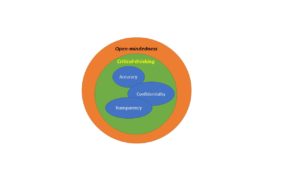SPOT: The Problem Statement-Study Method Connection

Why is the Problem Statement so Important?
A practical problem statement should raise “the questions asked and the reasons for asking them” in the pursuit of a study as suggested by Cooper (2018, p. 186). Creswell and Creswell (2018) outline several specific research tips that offer a direction for creating an effective problem statement. Their initial suggestion is to have an engaging opening sentence that connects with the reader; however, they continue to describe several transitional elements that are significant to joining the problem with the subsequent research study effort (Creswell & Creswell, 2018). These transitional factors will include: 1) an identification of the actual research problem, 2) proper framing of the problem that is “consistent with the approach to the research study,” and 3) an in-depth literature review of the value of the study to be undertaken (Creswell & Creswell, 2018, p. 109). These are main components of a valid statement.
Paliwal, Vaya, and Khandelwal (2013) address the first two criteria by describing that a pathway is needed to ensure the identification of the actual research problem and its proper framing for resolution (Paliwal, Vaya, & Khandelwal, 2013). Their work focuses on the comparative similarities between human and computer learning as the same logic used to solve a problem in general. They advise that there are “fixed criteria of analysis” (Paliwal et al., 2013, p. 188) which includes the following steps: “analyze the problem statement, recognize inputs [variables] and applicable function, plan the problem, [and] carry out the plan”(Paliwal et al., 2013, p. 188). Proper topic framing begins with an analysis of the problem statement that drives the study design. The subsequent research methodology addresses the declared issue, i.e., the problem, employing a workflow to a problem resolution in the form of a research effort (Hewett, Kijsanayothin, Bak, & Galbrei, 2016; Hindle & Franco, 2009; Paliwal et al., 2013).
“A “problem” is an undesirable situation” (Harper & Rainer, 2000, p. 136). Harper and Rainer’s (2000) work in technology transfer suggests that the problem statement is essential to determining the available and appropriate technological solution based upon a review of the available literature (Harper & Rainer, 2000). They describe the close connection of the problem statement with an association with what they describe as a process (Harper & Rainer, 2000). Their suggested procedure begins with defined problem structuring effort resulting in a suitably designed research approach to solving the stated problem (Harper & Rainer, 2000).
Now Available at Amazon–
“Be The Hunter”
References
Columbus, L. (2019, June 16). Top 10 cybersecurity companies to watch in 2019. Forbes. Retrieved from https://www.forbes.com/sites/louiscolumbus/2019/06/16/top-10-cybersecurity-companies-to-watch-in-2019/#4b683b696022
Cooper, H. (2018) Reporting quantitative research in psychology: How to meet APA style journal article reporting standards (2nd ed.). Washington, DC: American Psychological Association.
Creswell, J. W., & Creswell, J. D. (2018). Research design: Qualitative, quantitative, and mixed methods approaches (5th ed.). Thousand Oaks, CA: Sage.
Galloppo, G., & Previati, D. (2014). A review of methods for combining internal and external data. The Journal of Operational Risk, 9(4), 83–103. Retrieved from https://franklin.captechu.edu:2074/docview/1648312043?accountid=44888
Harper, J. S., & Kelly Rainer, R. (2000). Analysis and classification of problem statements in technology transfer. Journal of Technology Transfer, 25(2), 135. Retrieved from https://franklin.captechu.edu:2074/docview/203651548?accountid=44888
Hassani, B. K., & Renaudin, A. (2018). The cascade bayesian approach: Prior transformation for a controlled integration of internal data, external data and scenarios. Risks, 6(2), 1–17. Retrieved from doi:http://franklin.captechu.edu:2123/10.3390/risks6020047
Hewett, R., Kijsanayothin, P., Bak, S., & Galbrei, M. (2016). Cybersecurity policy verification with declarative programming. Applied Intelligence, 45(1), 83–95. doi:http://franklin.captechu.edu:2123/10.1007/s10489-015-0749-8
Hindle, G. A., & Franco, L. A. (2009). Combining problem structuring methods to conduct applied research: A mixed methods approach to studying fitness-to-drive in the UK. The Journal of the Operational Research Society, 60(12), 1637–1648. doi:http://franklin.captechu.edu:2123/10.1057/jors.2008.125
Nagrecha, S., & Chawla, N. V. (2016). Quantifying decision making for data science: From data acquisition to modeling. EPJ Data Science, 5(1), 1–16. Retrieved from doi:http://franklin.captechu.edu:2123/10.1140/epjds/s13688-016-0089-x
Paliwal, D., Vaya, D., Khandelwal, S. (2013). Mathematical analysis of problem statements: Artificial intelligence. International Journal of Advanced Research in Computer Science, 4(3) Retrieved from https://franklin.captechu.edu:2074/docview/1443744864?accountid=44888
Schroer, A. (2019, April 10). 25 Companies merging AI and cybersecurity to keep us safe and sound. Built-In. Retrieved from https://builtin.com/artificial-intelligence/artificial-intelligence-cybersecurity










